Text
Józef Poniatowski’s women.
Part V. The rest of ladies who might have been of some interest to him
Good day everyone and let me share with the rest of information I possess on Prince Poniatowski's love interests. (Though, I have to admit, the ladies from this list were the least likely - from all the mentioned in these series of post - to have some kind of affair with Pepi.
To start I would like by Louise of Mecklenburg-Strelitz, the queen of Prussia.
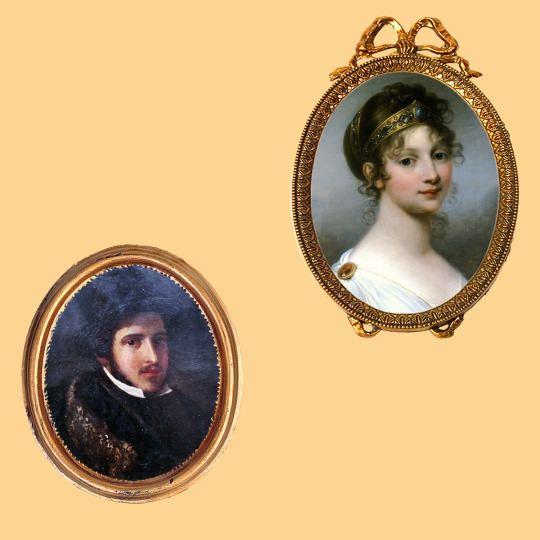
On the right - unidentified artist, miniature portrait of Prince Poniatowski, 19th century. On the left - portrait of Queen Louise by Giuseppe Grassi, 1802.
Prince Józef had the opportunity to meet the wife of the king Frederick William III at least four times, because the royal couple visited Warsaw - which had become a part of Prussia as a result of the third partition of Poland - three times, in 1798, 1802 and 1805. And in 1802 Poniatowski himself had to go to Berlin, to settle the matter of the inheritance left by his uncle Stanisław August.
According to Juliusz Fałkowski, while at Warsaw Prince Józef "…gave a ball and a dinner in the Copper-Roof palace in their honor [the King and Queen of Prussia - A.S.] and was flirting with the Queen everywhere", for which he received the star of the black eagle, although he rather "expected something else from the beautiful queen." After the departure of the royal couple, "he longed a little for the crowned beauty who had easily won his heart in passing."
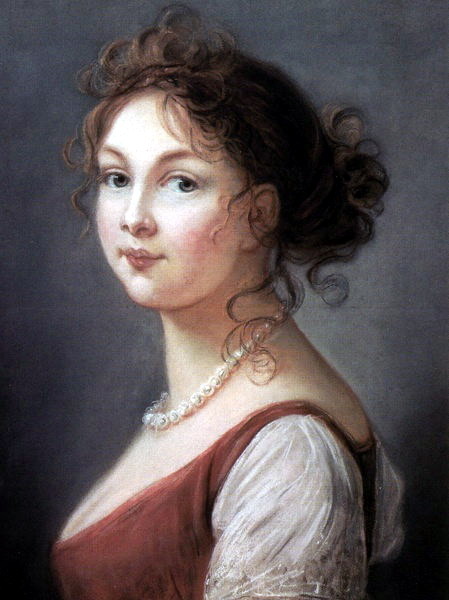
An Elisabeth Vigée-Lebrun painting of Queen Louise, c. 1801
The second source that mentions the relationship between these two is the book by Marian Brandys "Kozietulski i inni", which states (without giving sources, unfortunately) that during Pepi's visit to the capital of Prussia "… it was also said that the beautiful Queen Louise fell in love with in a knightly Pole."
However, if you ask my opinion about the likelihood of an affair between Pepi and the Queen of Prussia, I will say that in my opinion he was "flirting" her to make it easier to solve the inheritance problem. As for the fact that she could also be in love with the prince, I have no opinion because my knowledge about Queen Louise is not very great.
The second lady in today's list will be prince Józef's first cousin once removed, Anetka Potocka (née Tyszkiewicz, the daughter of Konstancja Poniatowska and a grand-daughter of prince Kazimierz, the oldest of the Poniatowski siblings).

On the left - Poniatowski's portrait by Franciszek Paderewski, on the right - Portrait of Anetka Tyszkiewiczówna, Giuseppe Grassi, 1796.
Born in 1779, she was 16 years younger than Pepi, and she remained unmarried for quite a long time, becoming the wife of the Count Aleksander Potocki in 1805. (Marian Brandys, in the biography of Anetka's uncle prince Stanisław, states that some time before 1791 there was an idea to join all the Poniatowski estates marring Stanisław to his niece, but it was eventually abandoned.) The marriage brought them three children, but after 16 years Anetka asked for divorce and then wedded Colonel Stanisław Dunin-Wąsowicz.
During the times of the Duchy of Warsaw, she was a frequent guest at the Copper Roof Palace, visited Paris, witnessed Napoleon's sojourns in Warsaw, with all of those events been described later in her memoirs.
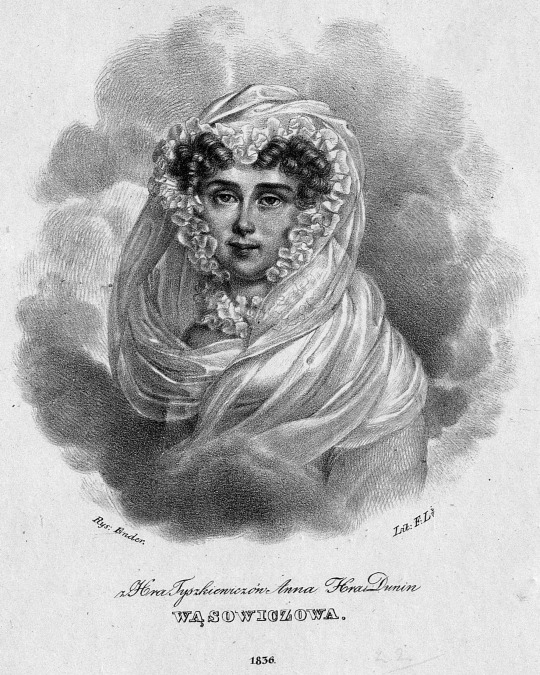
Portrait of Countess Dunin Wąsowicz, Anna née Tyszkiewicz, 1836.
As for her relationship with Prince Józef, it were her own words that made Fałkowski write that "the beautiful prince fell in love with Anetka" although "it was a platonic feeling".
"… Mrs. Aleksandrowa (Anetka Potocka - AS ) herself half-admitted thisin her old age. ''On disait alors que le Prince Joseph avait pour moi un sentiment plus tendre que l'amitié (it was said that Prince Joseph had for me a feeling more tender than friendship),' she would recalled with a dreamy expression on her face."
The second thing that leads historians to believe that Pepi could have distinguished this cousin of his from other relatives is the provision in his will, according to which she was to receive, after the death of the prince's sister, Teresa Tyszkiewicz, his favorite palace in Jabłonna near Warsaw. And when this did happen, Anetka ordered a triumphal arch to be built in the park in memory of Prince Józef.

The palace in Jabłonna, 2019
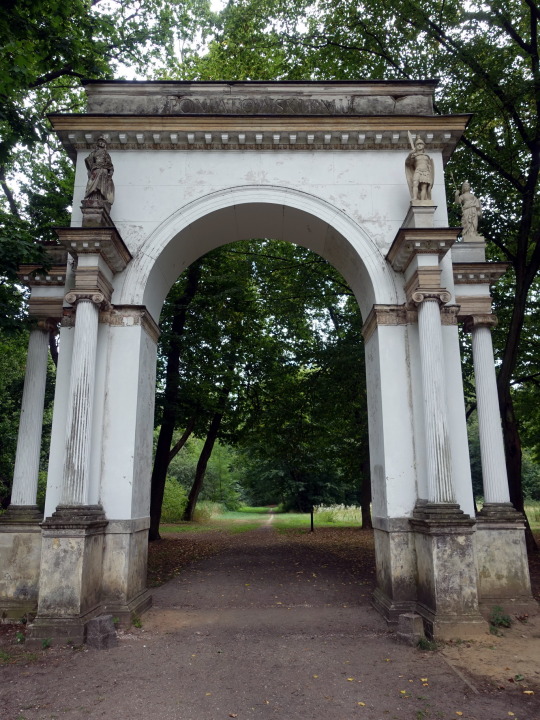
The triumphal arch from Jabłonna's park, 2019
And collage of mine is an illustration to the part dedicated to the rest of the women, whose portraits I wasn't able find. And honestly, the evidence that they might have been Prince Józef's love interests is very weak. But, since historians from time to time do mention these ladies' names, I thought them worth being included as well…
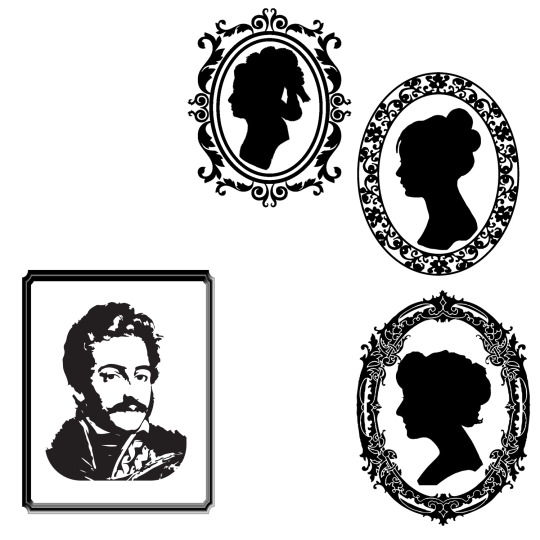
For example, in the prince's testament, together with Henriette de Vauban, Zofia Czosnowska and the above mentioned Anetka Potocka, there was mentioned Elżbieta Merlini, the daughter of Dominique Merlini, an Italian architect, the last main builder of the Polish-Lithuanian Commonwealth. But such concern for the architect's daughter may have been explained by a sense of moral debt to her father, which the prince Józef inherited from King Stanisław with the rest of the things.
Then, the list of Pepi's women sometimes complemented by another "Elżbieta" - Cichocka (although her real names were Emilia Karolina - or Katarzyna) née Bachmińska I° voto Szymanowska, II° voto Cichocka, III° voto Abramowiczowa. It is said she even sojourned in Jabłonna before 1810, until being apparently forced by Zofia Czosnowska to leave the place. After that Madame Cichocka went to Vilna, where she married her third husband. However, what IMHO should be taken into account in regards with this lady is that her second husband, Michał Cichocki, was an illegitimate son of Stanisław August, which might have made Prince Józef consider her a relative and thus take care about.
The same can be said about Madame Kicka - Józefa Martyna Rozalia née Szydłowska, who was a sister of Elżbieta Grabowska, another mistress of King Stanisław.
Sometimes the names of women who were friends and companions of Madame de Vauban are also included to the list of prince Józef's love interests. Those are: Anna Krasińska, a relative of general Krasiński and the wife of Mikołaj Oppeln-Bronikowski; Salomea Wielhorska née Dembińska; Anna Trębicka née Czerska, future wife of general Kamieniecki, and Józefa Potocka née Sollohub.
PS. As the regular visitors to the Copper Roof Palace are as well mentioned two ladies of the surname Walewska: Józefina née Lubomirska, the wife of Adam Walewski and the future wife General Witt, and Maria, the wife of Anastazy Walewski. The first of them was known for her kind of loose behavior, so presumably she might have at least flirted with Pepi; the second one is the famous Maria Walewska, but all I know about her makes me think her love for the emperor left no room in her heart for other men.
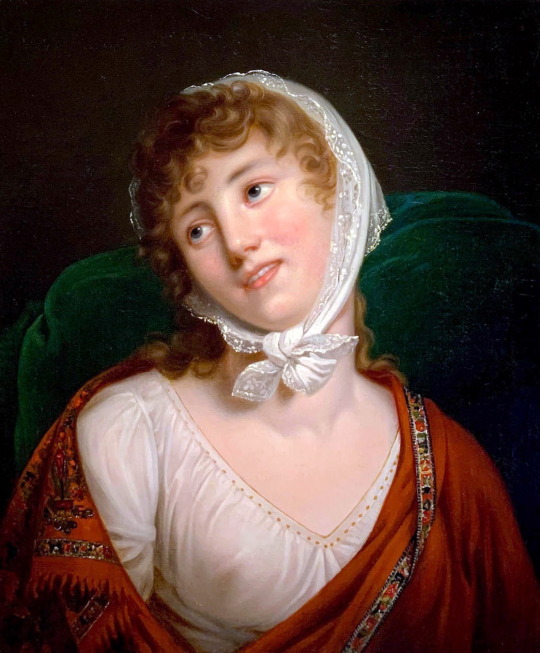
Portrait of Maria Walewska by Robert Lefèvre
#poniatowski#józef poniatowski#józef poniatowski’s women#queen Louise of Prussia#Giuseppe Grassi#Anetka Potocka#Jabłonna#Jabłonna palace#Maria Walewska#Robert Lefèvre
9 notes
·
View notes
Text
Napoleonic era fiction
Having shared with you the history books about the Napoleonic era I've read recently, let me talk a little bit on the topic of historical fiction. (Not that I read this kind of book much, but there are some I'd like to express my opinion of.)

The first one in my list will be La Victoire de la Grande Armée, by the former French President Valéry Giscard d'Estaing. It's an alternative history book, where it is imagined what might have happened if in 1812 the Grand Armée had left Russia just after the battle of Moscow. (A spoiler - as one can guess from the title, everything should have went well for the Napoleonic France).
Alas, there are a lot of discrepancies in the book (like, for example, Poniatowski and Grouchy are marshals already in 1812); in additional, the protagonist (a general named François Beille) seems to be a kind of Marty Stu. Nevertheless, I liked this book, because... in that reality prince Józef didn't die in the battle of Leipzig (because the battle just didn't take place)! On the contrary, he's being made the king of the the restore Poland (though, I must admit, Poniatowski in fact didn't long for a crown - more on the topic here).
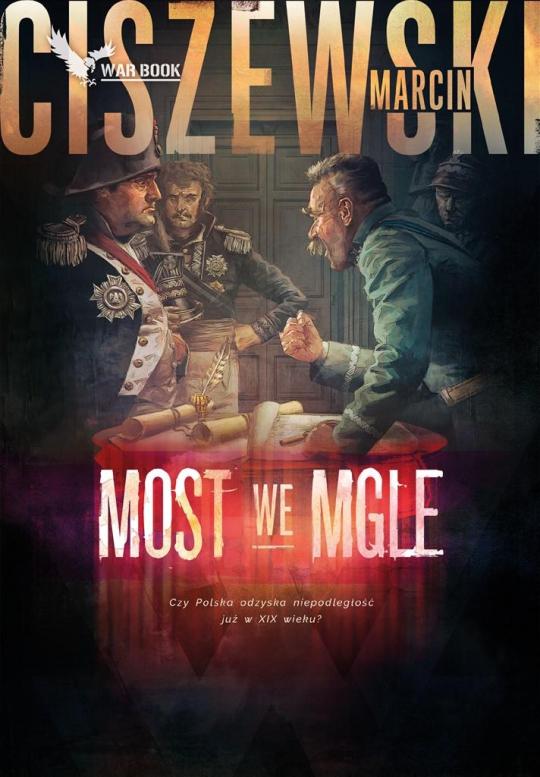
2. Having touched the topic of alternative history I can't help omitting another book (which, unfortunately, hasn't AFAIK been translated to any foreign language that's why I can now recommend it to my Polish speaking friends only). The book's title is Most we mgle (A Bridge In A Fog) and it is written by Marcin Ciszewski.
The plot is that in 1930ies Poland there appeared a time hole leading to 1813, using which a squad of the Polish soldiers was able to go back in time and change the result of the battle of Leipzig. So, in that universe prince Józef didn't die either )) (Though even there he had to become a king ;))
3. From alternative history of Poland let's switch to the real one, and here I have to digress a little to introduce you the next set of book. A friend of mine had once recommended me The Polish trilogy, a series of book by an American writer James Conroyd Martin, mentioning that in one of the books prince Józef's death in the battle of Leipzig is described. (A spoiler - there was such a scene in the second book, but it was not the most detailed description of the event I've stumbled upon, given all the books on the topic I've read, though it may be the only of those written in English.)
Having started to read the first book, I soon discovered that it wasn't an entire fiction, but was based on a real diary of a woman, Anna Maria Berezowska-Stelnicka, who lived in Poland in the end of the XVIIIth century. The diary was inherited by her descendants who live now in the US, and it was also translated to English and published and this is a book I do recommend to read:
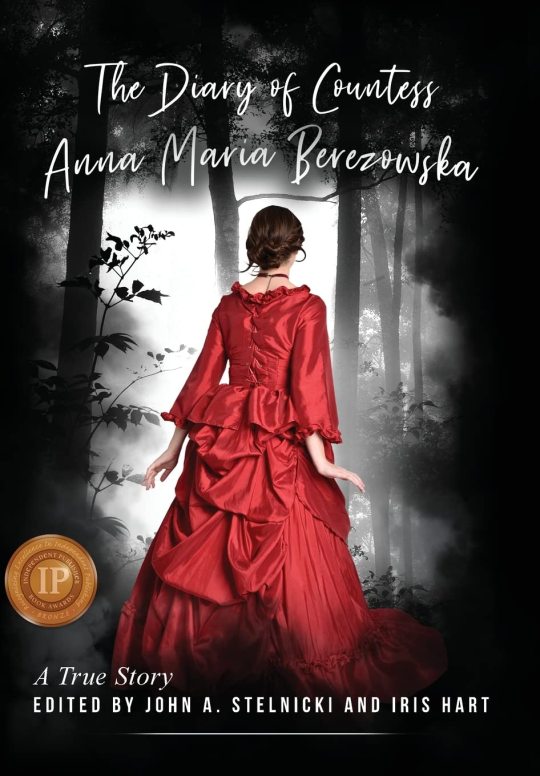
4. And what about the book series? Alas, here I can't be so enthusiastic.
First, it contained a lot of typos (in Polish names etc.; it might have been fixed in the Polish edition, but I was able to find the English one so I read it) and even some historical (for instance, women working as civil-cervants' secretaries of Russian administration in Warsaw in 1830-ies) and geographical discrepancies (for example, according to the author to the East of Warsaw there are stepps which go all the way to Moscow).
In addition, I didn't like how Martin adjusted the real characters from the diary on which he based the first book of his. Also, it surprised me that John Stelnicki, Anna's descendant who is the current owner of her diary, chose a male writer to process the diary into a fiction story (in my opinion, in the book there were scenes where the female protagonist would act illogical and unfeminine and those were the scenes not present in the original diary).

And the second and the third books aren't at all based on the diary events - the action of both diary and the first book, Push not the River, ends in 1794. The second one, Against a Crimson Sky, is set in the span from 1794 to 1814, the last one, The Warsaw Conspiracy, is dedicated the Polish November Uprising which started in 1830 and lasted till October of the next year.
The second book I liked more (and it was there where prince Józef's death was described), but unfortunately, the discrepancies between the characters behavior and how real people of that time did think and act (if to compare with the real diaries and memoires of other real people) only enhanced. (Though it was kind of fun to recognize whose memoires the author was using to describe this or those event).
The last book... well, the November Uprising isn't really my cup of tea, so there were less things there that did catch my eye (but nevertheless, as I've mentioned above, they were). And I was really disappointed that in the epilogue of the book there was nothing about how Anna's family got to America. For because of the Uprising they had to leave Poland everything pointed out that they or there descendants wouldn't have return to the motherland until Poland gained independence in 1918... That's why, taking into account that Anna's descendant who is the owner of her diary does live in the US, it seemed to me it was worth to mention that the family moved to the New World (even if the real chain of events due to which the diary ended in the US couldn't be restored).
5. And the last image is to illustrate more of a question than a recommendation. For the sake of inspiration I decided to look for historical romances where the story is set in Napoleonic France. But, to my great disappointment, it turned out that there are not very much of them. The French Wikipedia in fact mentioned the only one series of books - Juliette Benzoni's Marianne, the set which I read, and even more than once. But those books, in my opinion, though may arouse interest in a person of fourteen, but can't IMHO inspire people in their forties (at least due to the fact that the main love interest of the heroine is a cynical abuser).

That's why I would like to ask you, my friends, for a recommendation of historical romance with the action set in Napoleonic France or its satellites (and where the protagonists are, of course, on the French side ;))
#Valéry Giscard d'Estaing#1812#napoleon#La Victoire de la Grande Armée#Józef Poniatowski#napoleonic era#napoleonic era fiction#Most we mgle#Marcin Ciszewski#alternative history#Anna Maria Berezowska-Stelnicka#James Conroyd Martin#The Polish trilogy#historical romance
10 notes
·
View notes
Text
Books about Napoleonic era (and Polish history) - 3
Good day, dear all, and let me share with you some books I've read recently.
And because today is the birthday of Tadeusz Kościuszko I'll start with a biography of him The Peasant Prince, by the American historian Alex Storozynski:

2. One more position about the Polish history, in English, I'd like to recommend you is Richard Butterwick's The Polish-Lithuanian Commonwealth, 1733–1795: Light and Flame, dedicated to the reigns of Polish-Lithuanian two last kings, Augustus III Wettin and Stanisław August Poniatowski:
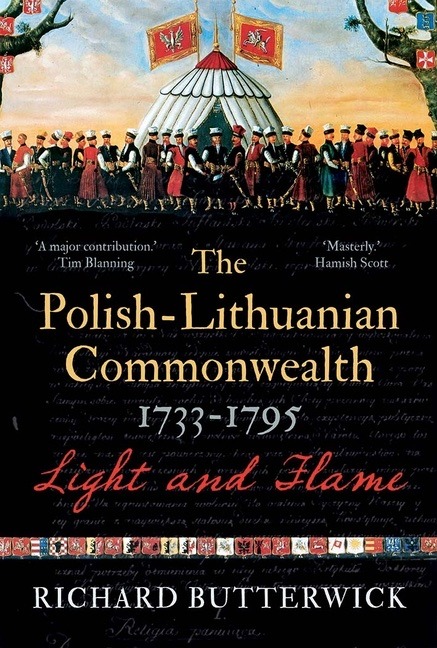
From the topic of Polish history let's switch to the French one.
3. One more addition to my collection of Talleyrand's biographies was this one, written by Robin Harris:

4-5. Then, there were two books about Napoleon's private life, by Octave Aubry and Sigrid-Maria Größing:
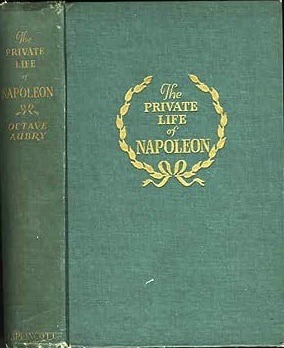

6-7. A study on the topic of French revolutionary and imperial generals, by Georges Six, and George Nafziger's Imperial Bayonets. (These were books with lots of military details, so I can't say I've enjoyed them thoroughly, rather not belonging to their target audience))


8. And this is a book I really liked, The anatomy of Glory by Henry Lachouque! And though its subtitle (Napoleon and his Guards) kinda states the book will be focused on the Imperial Guards, in fact its topics turned out much more wider, including information on Napoleon himself, France and even some details of the usual life of that times:

9. The book majority of you have already read, The Iron Marshal, a biography of Louis Nicolas Davout by John Gallaher:

10-11. And the last but not the least - two books on Murat. The first is a book by the French historian Jean Tulard and the second is an impressive work of Sarah Hammel @joachimnapoleon.


Thanks a lot, Sarah, for letting as see Joachim Murat through his letters, from his own point of view!
#books#napoleonic era#history books#kościuszko#tadeusz kościuszko#Alex Storozynski#Polish-Lithuanian Commonwealth#Richard Butterwick#Talleyrand#charles maurice de talleyrand périgord#Robin Harris#napoleon#napoleon bonaparte#Octave Aubry#Sigrid-Maria Größing#Georges Six#George Nafziger#Henry Lachouque#Louis Nicolas Davout#John Gallaher#joachim murat#jean tulard#Sarah Hammel
38 notes
·
View notes
Text
Józef Poniatowski’s family album
Part III. Maternal relatives
Because prince Józef's mother wasn't Polish, the information I have about her family is much less in comparison with the Poniatowskis. Nevertheless, there is still something on the topic I can share with you.
As I wrote before, prince Józef got his first name in honor of an uncle, his mother's brother. Et voila - here he is:
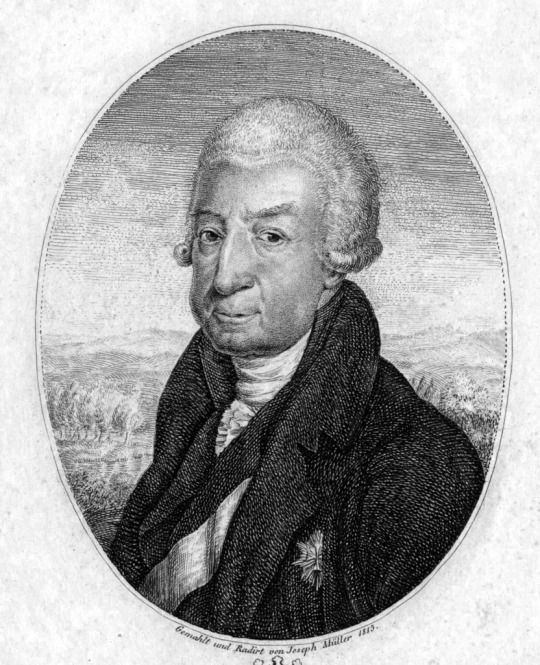
Filip Josef Count Kinský of Vchynice and Tetovo
Being born in 1741 he was a year younger that Teresa. And apart from those two among the sibling there were also the older brother Franz Ferdinand and the younger sister Maria Anna.
As stated in the German Wikipedia (there is no information about him in English), he chose a military career resigning in 1783 from the imperial army with the rank of major general.
His personal life, however, didn't look like a happy one. According to a family contract, he was engaged to his cousin Marie Auguste but she died in 1763 not coming of age. In 1787 Filip Josef married the Countess Maria Theresia von Dietrichstein who was 17 years younger than him. But she left him shortly after the wedding and next year the marriage was annulled.
So it look like the closest person to Filip Josef was his sister Teresa, prince Józef's mother. As stated in the article, she often visited him in Chraustowitz Castle, a residence he inherited from their mother. In Teres's honor, Filip Josef even built a small hunting castle Theresienlust (of which only the ruins remain).
One more interesting fact to add here is that the mother of the Kinskys siblings was of Italian origins, born Maria Theresia Capece, marquise di Rofrano.
Who else of the Kinskys is IMO worth to mention it is prince Józef's third cousin, Ferdinand, the 5th Prince Kinsky of Wchinitz and Tettauv:

Lithograph by Josef Kriehuber
Doesn't he look a little bit like prince Józef? ;)
But Ferdinand was 18 years younger than Poniatowski, he was in 1781, in Vienna (the latter fact makes probable prince Józef, who was living in Vienna that time, knew about such a cousin of his).
And Ferdinand Kinsky also chose a military carrier, he took part in the war of 1809; however, his regiment wasn’t among the ones which invaded the Duchy of Warsaw, captain Kinsky’s battalion fought the French in the battles of Regensburg, Aspern and Wagram.
I didn’t find any information whether Ferdinand Kinsky participated in 1812 in Napoleon’s Russian campaign, but he found his death in that very year. While inspecting his estates in Weltrus he fell from his horse and died shortly afterwards as a result of the accident.
Also prince Józef might have known two brothers, Josef and Franz Josef Kinskis, who also were his third cousins and as well served in the Austrian Army (being a thirty years older than Poniatowski they might have provided some protection over him when he was starting his military career).
In addition, there was a Dutch line of the Kinskys family, from whose representatives Franz Friedrich was a contemporary of prince Józef but I have very much doubts whether Poniatowski knew those people.
8 notes
·
View notes
Text
Do you know that on occasion of Napoleon’s coronation there was as well a balloon launched in Paris? I even managed to find some images showing this:
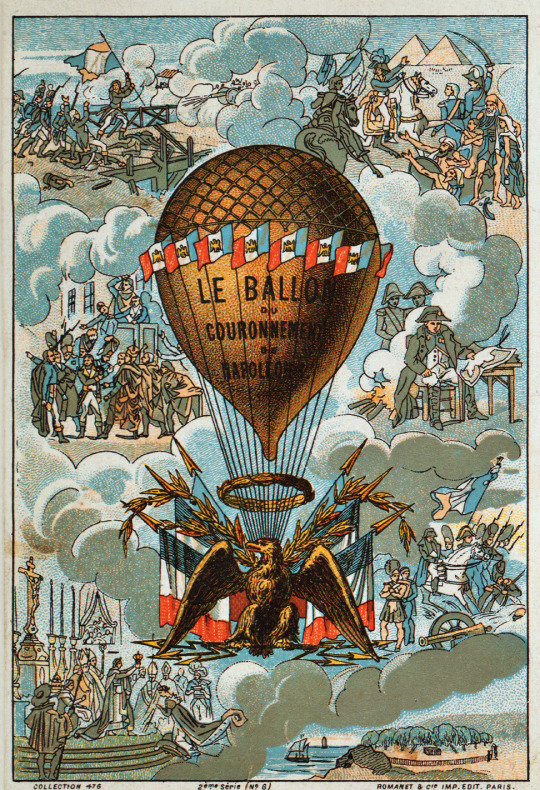
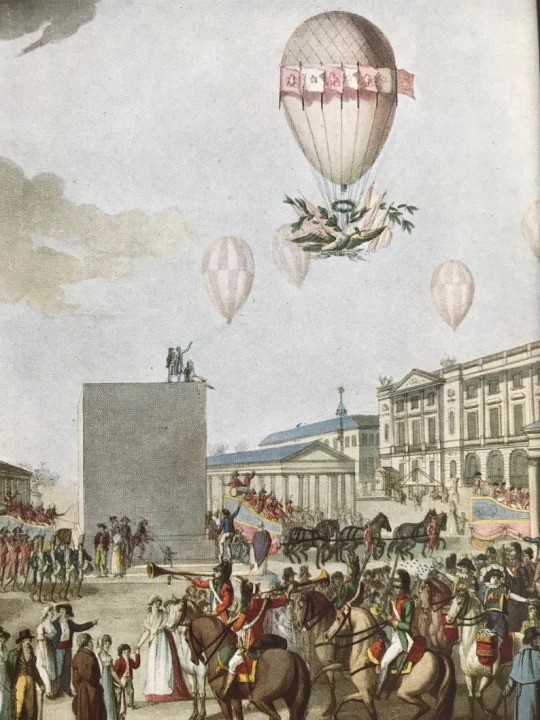
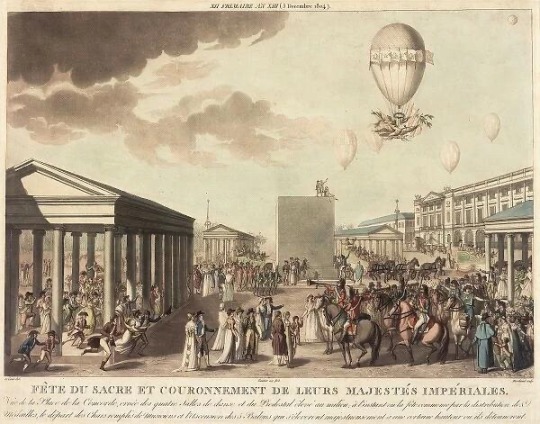
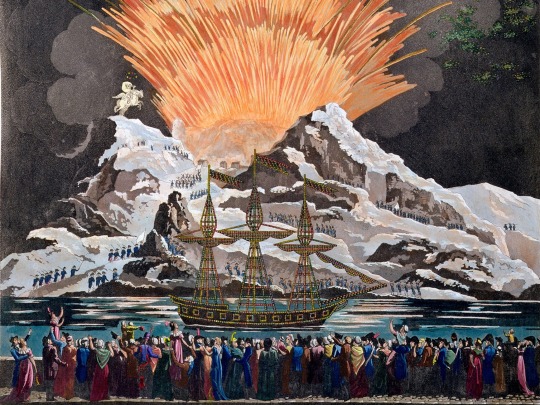
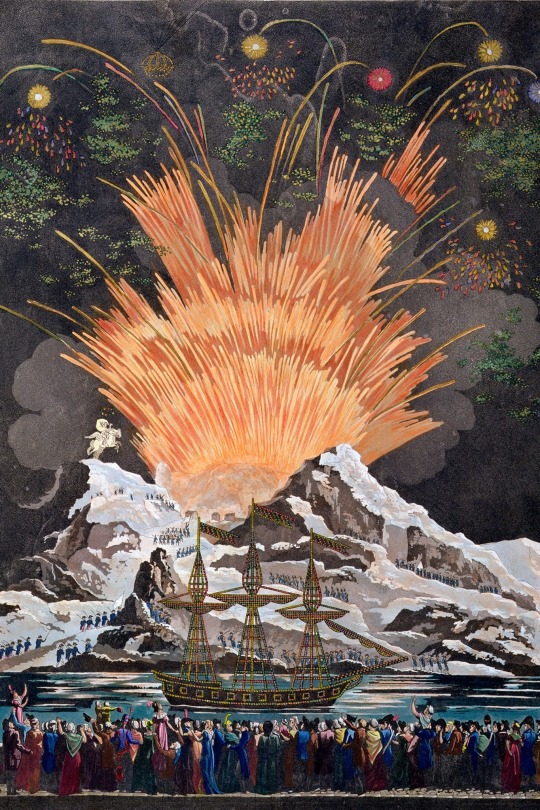
Fête du sacre et couronnement de leurs Majestés Impériales
Coronation of Napoleon I, 2 December 1804
Fireworks burst from behind a mountain at the Sacred Festival and Coronation of their Imperial Majesties in Paris, France, in the early 1800s.
View from the Place de Grève of an illuminated ship, emblem of the city of Paris, on the river and fireworks on an artificial mountain landscape, a tableau representing the passage of the Mont St. Bernard, on the opposite bank.
15 notes
·
View notes
Text
Finding the body of Prince Józef
Having finished the series about the last year of Prince Józef's life, it is impossible to ignore the issue of finding his body, especially since many paintings illustrating that event were created in that era and later.

The Allies began searching for the bodies of those killed in the Battle of Leipzig already in the afternoon on the 19th October.

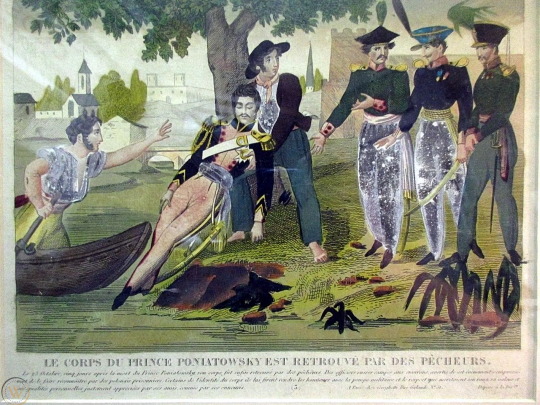
Prince Poniatowski's body was found only on the 24th, a very short distance from the place - about three hundred steps - where he tried to cross the Elster. It was recovered from the river, according to Szymon Askenazy, by Leipzig fishermen Johann Christian Friedrich and Johann Christian Meissner, and their assistants Adam Solten and Beniamin Meissner.


At the time of his death, the prince was wearing a Polish general's uniform, with a Virtuti Militari cross on his chest; some sources even state that being found he still was holding a broadsword in his hand. However, the wig Poniatowski used to wear, together with the artificial sideburns attached to it, slipped off the prince's head and wasn't found together with the body.
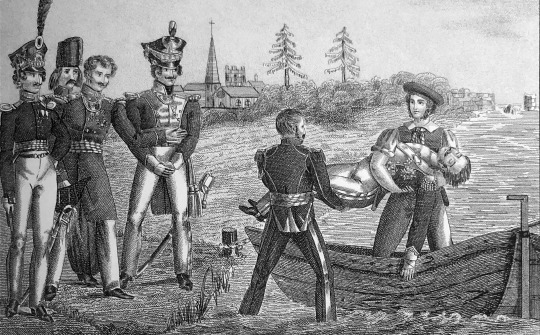

This circumstance made the identification of the body rather difficult. (Though, I had to say, the body’s state wasn’t as bad as it might be expected on the 5th day after death - the cold water kinda preserved it. Antoni Ostrowski even states that prince’ face was serene, smooth and beautiful as in life. But others wrote that there had been a dark spot on his forehead.)
Nevertheless, the Polish generals who had been taken by Allied as prisoners of war - Grabowski, Kamieniecki, Krasiński, Rożniecki and Umiński - recognized in the deceased man his commander...

Czesław Tański, Prince Józef's body recovery from the Elster
One of the images from my collection even shows prince Józef without his wig (though with sideburns, and moustache - about which I am still not sure whether Poniatowski) was wearing it at the time of his death:
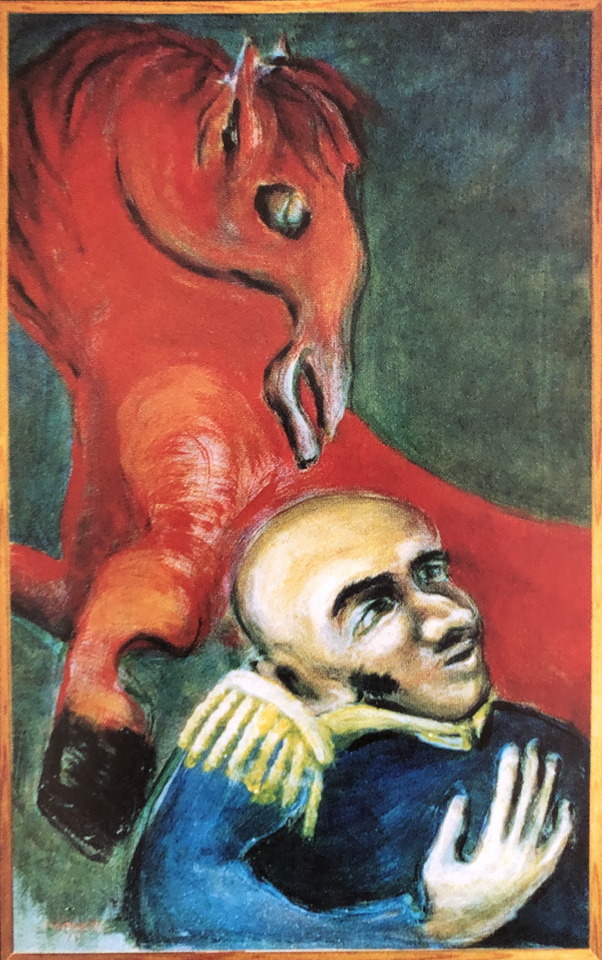
Leszek Woźniak, prince Józef drowning
Having being found, Poniatowski's body was then deposited in the underground vault of the city hall of Leipzig (it was there where the official recognition was made).

Charon, Soldiers carrying the body of Prince Józef
Then it would be buried in the church of St. John (but this is the topic for another post...)
52 notes
·
View notes
Text
The Battle of Leipzig, October, 1813
By mid-October, Napoleon gathered all his forces near Leipzig, where on the 16th the started a battle that would later be called the Battle of the Nations .

Jan Czesław Moniuszko, Prince Józef at Leipzig
Commanding the Poles incorporated into the Grand Army as the 8th Corps, Prince Joseph defended the village of Markkleeberg south of the city. As he reported to Napoleon, on the 16th
"the enemy did not gain an inch of ground […] the army showed admirable zeal and endurance […] but I lost 1/3 of my men and I have no ammunition."
And on that very day, the 16th of October, the Emperor appointed Prince Poniatowski a Marshal of France, with the official nomination taking place a day later.

Prince Józef Poniatowski being presented the marshals baton, Reville's engraving after Martinet
As diarists recall, prince Józef received both the news about the nomination and the announcement that followed quite calmly, or even indifferently. However, he considered that moment not appropriate to insult the emperor with a refusal.
So first Poniatowski asked consent of Frederick Augustus, King of Saxony and Duke of Warsaw, to accept the nomination. Then he hastened assure his subordinates that
"whatever happens he would never replace the Polish uniform with another one."
Also anticipating that the news of his new appointment might not receive support in Warsaw, prince Józef asked Tomasz Ostrowski
"to send to the capital as early as possible, by a known means, an explanation of the circumstances and an assurance everyone that if there is no war for Poland, no one will see him wearing anything but a civilian clothes".
Together with this, however, Poniatowski promised that in any case he would have to escort Napoleon to France.
As for the global situation, the 17th of October was a day of rest and re-ranking of troops for both the Frenchmen and the Coalition , thus there was almost no fighting then.

Polish infantry fighting at Connewitz-Probstheida, a drawing by Raffet
On October 18, Prince Joseph was defending Probstheida, a village southeast of Leipzig. But that day the fighting was even more fierce than before. The French troops held their positions, but by the end of the day they were exhausted and depleted as a result of the intensifying attacks of the Allies, who, in addition, had on the previous day received reinforcements in the form of General Bennigsen's Czech Army and the Army of the North commaded by Bernadotte.
Considering all this, that evening Napoleon considered the battle a lost cause. So, he then began organizing the retreat. The corps of General Reynier, Marshal Macdonald and Prince Poniatowski were to defense the rear guard of the French. They were to hold the city of Leipzig for 24 hours for the Grande Armée to gain as much time as possible.

Napoleon resigns after the Battle of Leipzig, From a painting by Ludwik Braun
Having arrived in Leipzig at nine o'clock in the evening, Napoleon stayed at the hotel "At the Prussian king", where he asked Prince Józef to come. They then had, according to Baron Agathon Fain's account, the following conversation:
- Prince, you will defend the southern suburbs.
– Sire! I have very few men, most of my corps have, following Prince Berthier's orders, crossed the Elsther at night.
- How many Poles are there with you?
- My usual escort, i.e. two hundred of the Krakuses, the same number of cuirassiers, staff and several cavalry units, in total about eight hundred people.
- Well, this will be the way for you to defend the southern suburbs and cover the retreat of the army with the Prince of Tarentum… For 800 Poles are worth 8,000 other soldiers.
- Your Majesty can trust us, we will cover the retreat, even if every one of us dies!
These were the last words the prince addressed to the emperor. After saying goodbye he looked "preoccupied and sad".
What's more, that meeting was probably the last time Poniatowski and Napoleon seeing each other...
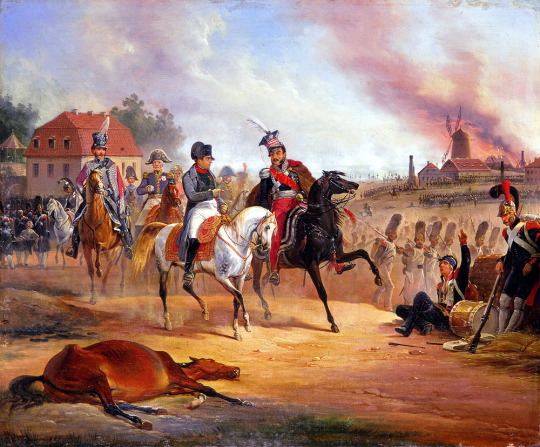
January Suchodolski, Napoleon and Józef Antoni Poniatowski at the Battle of Leipzig
On the morning of the last day of the battle, Polish troops were defending a section of the southern suburbs near the Peters Thor gate. Moreover, that time they had not only to fight the enemy, but also there intensified clashes with the locals, who were shooting at the retreating units from the windows.

Author Unknown, Prince Józef Poniatowski during the Battle of Leipzig
At about 11:00 Prince Józef found it impossible to conduct further defensive operations in this place and ordered a retreat. The Poles moved along the esplanade, where, near the Wasserkunst fountain, they fight the enemy in an organized manner for the last time.

Jan Chełmiński, Prince Józef Poniatowski at the head of the troops at Leipzig
During that skirmish Poniatowski was probably wounded (probably not first time). As Klemens Kołaczkowski recalled:
He received a wound in the hand from a rifle bullet; he ordered it to be treated, got back on the horse and, holding his hand on a scarf, he did not stop fighting.
Then the Poles, having left the city walls, were looking for a crossing. The first on their way was the Pleisse River, deprived of all bridges on Napoleon's orders. Kołaczkowski:
Prince Poniatowski <…> was exposed to the fire of enemy tirailleurs, in dense troops approaching from all sides. General Bronikowski, standing next to the prince, advised him to seek salvation by swimming. But the prince answered him quickly: "One must die bravely!" (Il faut mourir en brave - AS) He ordered the rest of the escort to attack enemy tirailleurs one more time, but that managed to stop their advance only for a moment. There was not a single moment to lose! In this last resort, the prince finally followed the opinion of the officers surrounding him, mounted his horse and jumped into the river with him!
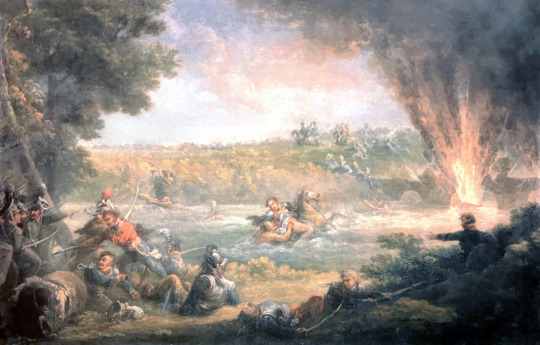
Jan Bogumił Plersch, Prince Poniatowski crossing Pleisse
The water was flooding the banks high up; the horse, carried away by its momentum, could not reach the shore. At this sight, captain Blechamps from the staff rushes after the prince, helps him swim and get to the opposite shore.
But there was one more river to cross – the Elster. Which had also been devoid of all its bridges except one. But even that one was earlier that day blown up by mistake when a significant part of the French were still on the other bank.
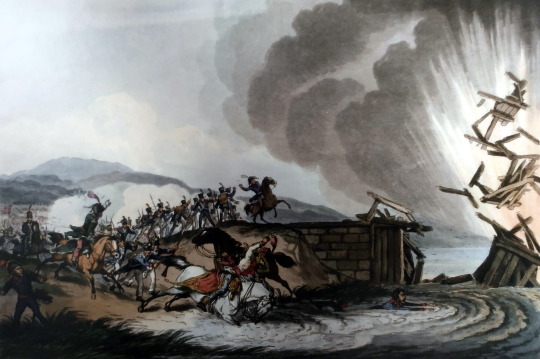
Retreat of the French from Leipzig, October 1813, an English engraving
What's more, in German Elster means "magpie". And according to legend, a gypsy woman once told Prince Joseph that he would die because of a magpie. And that's how it happened.

Tadeusz Korpal, Prince Poniatowski at Leipzig
Kołaczkowski:
The prince was walking on foot through the gardens lying between Elster and Pleisse: here, he was shot in the side by a rifle bullet for the second time and fell into the arms of the officers surrounding him. However, he soon regained consciousness and, with the help of his adjutant, mounted his horse with difficulty, swaying in the saddle. The Poles started to appeal to him to take care of himself and, handing over his command to another general, to preserve himself for the homeland. But the prince's courage seemed to increase with danger. "No! no!" he shouted "God has entrusted me with the honor of the Poles, I will only give it to God". The engineer's officer comes running and points to the most convenient place to cross; the prince, walking along the river bank, heads in that direction; but when he notices the enemy unit blocking his path, he shouts loudly: "There they are!" He turns his horse and rushes to Elster. Weakened by his wounds, he can no longer steer his horse, but the beast can only follow the current and cannot climb the high, precipitous shore. All this happened under a hail of bullets. At that final moment, the prince receives his third wound, slips from his horse and, carried away by the rush of the water, begins to sink. The good Blechamps comes to the aid again. In noble zeal, he throws himself into the river and grasps the prince. He was seen holding his arms and trying to lift the prince's head above the water, but the efforts of this noble man were in vain. They both disappeared forever in the currents of the treacherous river! Such was the death of a Polish hero, a beloved leader who preferred death to ignominious captivity.

Prince Poniatowski at Leipzig (enlarged)
According to another legend, at Leipzig prince Józef was to see the notorious White Lady of the Poniatowskis for the last time.
#józef poniatowski#poniatowski#1813#Leipzig#the battle of leipzig#napoleonic wars#napoleon bonaparte#Jan Czesław Moniuszko#Ludwik Braun#January Suchodolski#Jan Chełmiński#Jan Bogumił Plersch#Tadeusz Korpal
28 notes
·
View notes
Text
Prince Józef’s last summer and September
Now let's go back to Prince Joseph's last year. Having met Napoleon in Dresden, he then returned to Zittau where he was to spend the next two months, continuing to train his soldiers.

Bronisław Gembarzewski, Before the Battle, 1813.
When in August the truce ended, the mission of the Polish Corps became to protect that part of the Saxony border from the Austrian invasion.
On August 17, at the beginning of the operations, Poniatowski was in Ostritz, from where he made it to Eckhartsberg on the same day; on the 20th he had quarters at Gabel, remaining there until the end of the month. On September 1, the Polish Commander-in-Chief returned to the Zittau area, to Eiöhgrube, the next day he was in Romburg, on the 3rd and 4th in Schluckenau, on the 6th in Lobau on the way from Zittau to the capital of Saxony.
The Austrians, however, chose a different route, so the Poles had their first clash only on September 9, with the rearguard of the Russian corps near Löbau. On September 11, Poniatowski camped in Neustadt, between the 12th and 20th he stayed in Stolpen, then four days in Rennersdorf, on the 25th and 26th he was in Dresden. Then the task of Polish Corps became to cover communications between Dresden and Leipzig while the Grand Armee was retreating from the Saxon capital, so on the 27th of September Poniatowski was already in Nossen, and on the 28th and the following days in Waldheim.
22 notes
·
View notes
Text
Prince Poniatowski’s narrow escape from the British Navy
(when visiting Gdańsk in 1810)
On the anniversary of the event happened 213 years ago just about this time let me share with you the story how prince Józef was nearly caught by the British Navy.

A collage of mine illustrating the whole story.
A short pre-history: in 1807, during the War of the Fourth Coalition, Gdańsk was taken by the Grand Armée and converted, along with its rural surroundings, into “the Free City”.

Adolphe Roehn, Entry of Napoleon and the French Army in Gdańsk 1807
Wisłoujście fortress, placed downstream the Vistula river also become the part of the French Gdańsk.
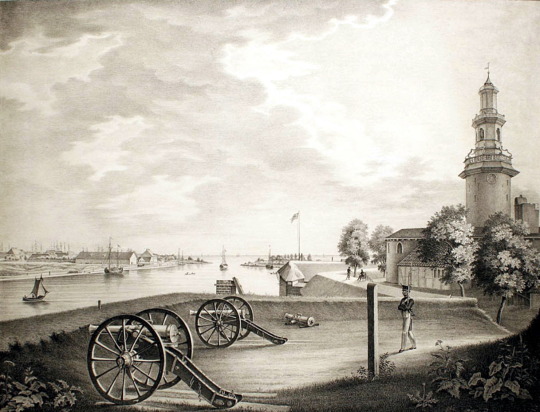
A lithograph according to C.G. Ludwig showing the Wisłoujście fortress in 1825.
And guess who a year later, in 1808, became the commanding officer of the French unit in Gdańsk? The brigadier general Michał Grabowski, prince Józef’s cousin, about whose death in the battle of Smoleńsk I wrote here.
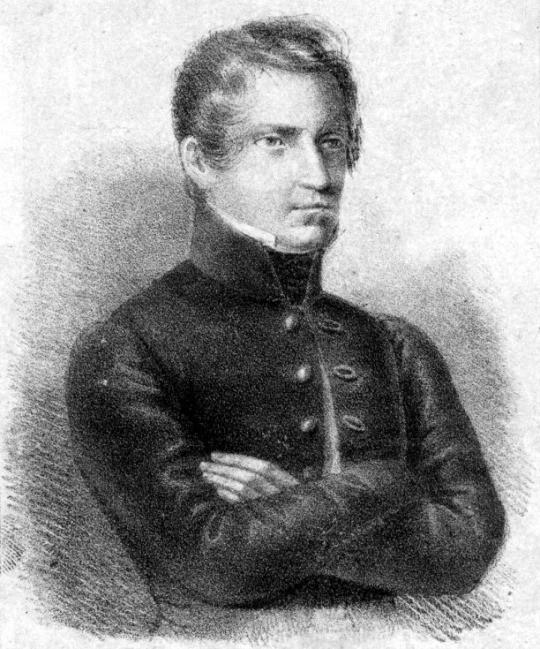
Michał Grabowski
And it looks like it was him who organized in 1810 a visit of prince Józef to Gdańsk. It is known that in the years 1808-1811 they remained in constant contact with each other. (And It is possible that Poniatowski might had contributed his effort for Grabowski to be transferred to Gdańsk 2 years prior.)
Prince Józef Poniatowski's visit to Gdańsk took place on August 14-19. During his sojourn in the city, he stayed in Mniszech Palace.

The palace didn’t survive the WWII, but here is a card showing how it looked like in the beginnig of the XXth century.
Celebrations related to the birthday of Emperor Napoleon took place - as it seems - not on August 15, but exceptionally on the 19th. First, a solemn Te Deum was held in the Dominican Church, then the was a military parade on Napoleon Square at the Oliwa Gate. In the afternoon, prince Józef visited Polish troops, and in the evening he took part in a ceremonial ball organized by general Jean Rapp, the governor of Gdańsk.

Jean Rapp
But the most interesting is what happened during Poniatowski's visit to the fortress of Wisłoujście. (Unfortunately, I don’t know when exactly this took place, but it looks like it was sometime between the 15th and the 18th of August.)
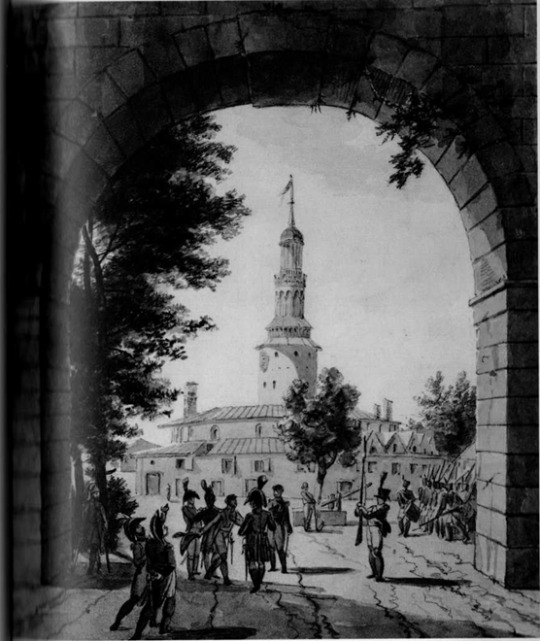
Nicolas-Antoine Taunay, Interior of the Wisłoujście Fortress, 1807
As journalists Waldemar and Nataniel Borzestowskis wrote in their article:
After leaving the lighthouse tower, he (prince Józef - AS) quite unexpectedly asked for a short cruise around the Bay. The heavy lifeboat was led to the Vistula and headed towards the sea.
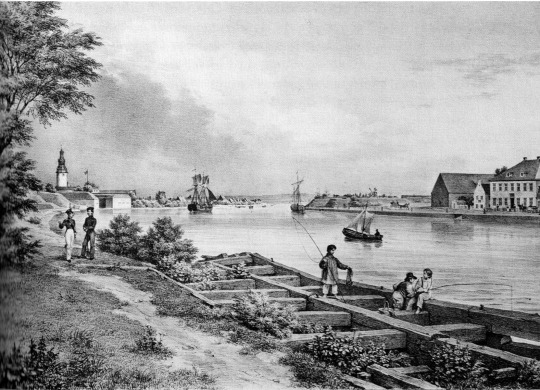
Friedrich Eduard Meyerheim, a view to Wisłoujście fortress and village, 1838
<...> When the boat had sailed far enough and was beyond the range of the cannons, boats full of Englishmen, hidden behind a rocky breakwater and sand dunes, started moving towards it. The alarm went up. It is not known whether it was a spontaneous action or, more likely, an ambush prepared for several days. If so, it would testify to the extremely effective activities of the intelligence hostile towards the French in the city and the urgent observation of the fortress in Wisłoujście and the vicinity of the port.
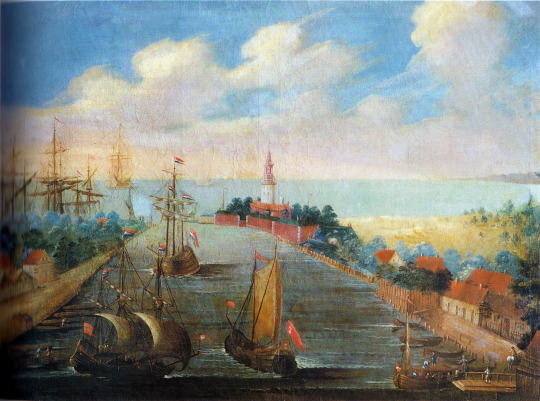
A view of the Vistula estuary and the fortress Wisłoujście with the Baltic sea in the background, an image from beginning of the XVIIIth century
For Prince Poniatowski, rescue came at the last moment. He owed his survival to the muscle strength of the oarsmen accompanying him, but also to the "cold blood" of the French commander of the fortress, who - observing the whole event - opened fire at the right moment, when the boats approaching the shore were close enough for the shot to be accurate and could effectively deter attackers. Those, seeing that they were dealing with not just any artillerymen, gave up the chase and fled behind the dunes.
The image of prince Józef I used to create the collage:
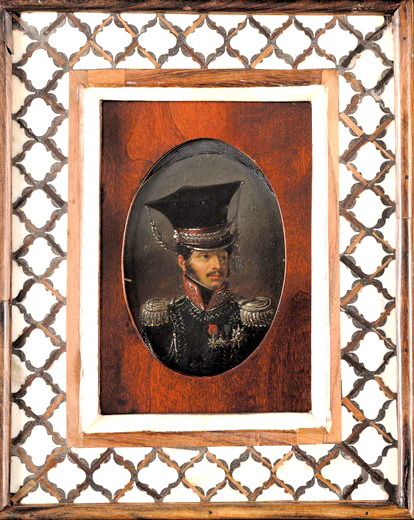
Jacques-Noël-Marie Fremy, Portrait of Marshal Poniatowsky in the uniform of General of Division of the Duchy of Warsaw
Prince Poniatowski, as the Borzestowskis state in the end of the section of the article devoted to this event, was clearly embarrassed by the adventure and the unexpected possibility of being taken prisoner by the English. But at the same time they wonder whether prince Józef might, in case if the capturing had happened, lived for a long time?
#Poniatowski#józef poniatowski#Michał Grabowski#gdańsk#1810#Napoleonic Wars#Jean Rapp#Mniszech Palace#british navy#wisłoujście#adolphe roehn#nicolas-antoine taunay#Jacques-Noël-Marie Fremy#photoshops#danzig
27 notes
·
View notes
Text
The Galician campaign of 1809
Today let me tell you a little bit about the Galician campaign of the Austro-Polish war of 1809, which proved to be a great success for the Duchy of Warsaw.
After the battle of Raszyn there happened the series of small battles, which prevented Austrians from crossing the Vistula, thus leaving the initiative on the right bank of the river firmly with the Poles. So, the Polish forces under Poniatowski’s command moved along Vistula to the South-East, to the lands Austria seized during the latest partition of Poland.
On the 14th of May the Polish Army entered Lublin:
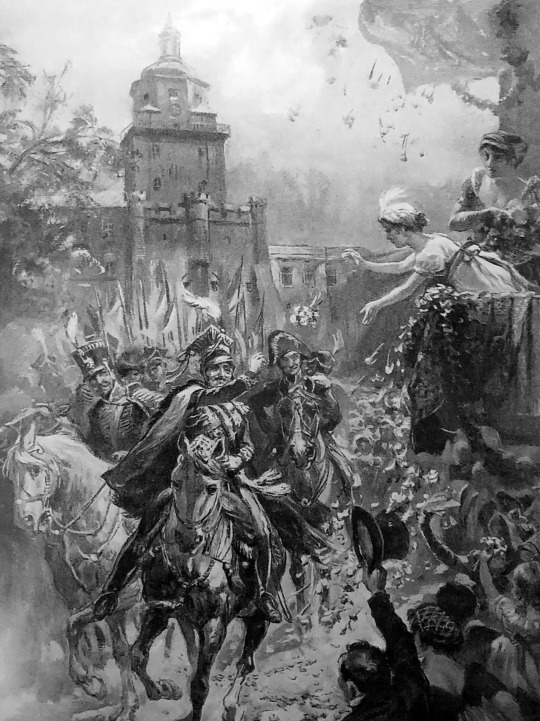
Konstanty Gorski, "Prince Józef Poniatowski enters conquered Lublin in 1809, showered with flowers by ladies"
As Kajetan Koźmian recalls in his memoirs, Poniatowski and his men were greeted with "joy and elation", and in the evening "... the city and the citizens gave a great ball <...> in the house in Korce. Prince Józef honored them with his presence starting the ball."
The next city on the way of the Polish Army was Sandomierz, and after a short siege it was taken on the 18th of May.

Siege of Sandomierz in 1809.

Michał Stachowicz, a scene from the battles in Galicia ("The Capture of Zamość")
Then there was Zamość, where the Polish trooped entered on the 20th of May.
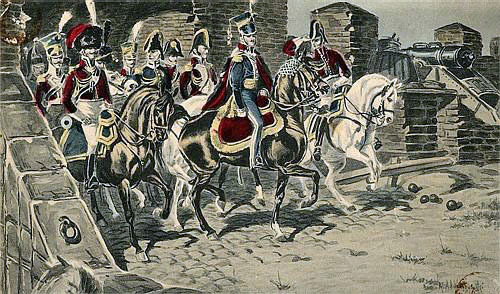
Siege of 1809, M. Adamczewski Entry of Prince Poniatowski to Zamość (postcard)
On the 27th of May the Polish advanced forces even reached the city of Lwów, but prince Józef wasn’t among them.
Meanwhile the Austrians under command Archduke Ferdinand realized the precariousness of their position in the center of Poland, and on the 1st of June left Warsaw for the south.
Poniatowski, for his part, decided not to engage with the Austrian, focusing instead on "liberating” as much Galician land as possible.

Prince Józef Poniatowski seeks information from local peasants in Galicia in 1809, a photo of Stanisław Bagieński's painting
On the 3rd June there appeared the third participant of the events - Russian forces crossed the Austrian border to Galicia as well. And though formally they were acting as Napoleon’s ally, as was prescribed in the Tilsit Treaty, their real goal was to prevent the Poles from taking too much of the Austrian-held territories.
So, to outwit the Russians prince Józef was taking Galician cities not in the name of the Duchy of Warsaw, but in the one of emperor of the Frenchmen. Like the proclamations were being made in the name of Napoleon, the eagles on the coats-of-arms replacing the Austrian ones were not Polish and French etc.
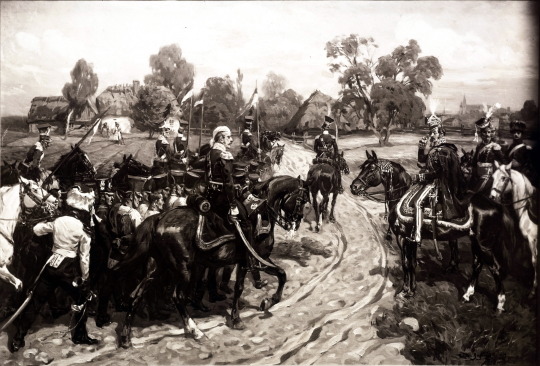
Lancers lead Austrian prisoners of war near Kraków in 1809, in front of Prince Józef Poniatowski, a photo of Stanisław Bagieński's painting
Then, in the outer theater of war on the 6th of July the French defeated the Austrians at the Battle of Wagram. And according Franco-Austrian truce signed five days later the land division was to take place along the line where the troops were at the time of receiving news of the truce, not at the time its signing.

The Austrian army leaves Wawel, a postcard based on the painting of Wojciech Kossak
And so began the race between Russians and Poles, to advance to as farther as possible.
In the middle of July both armies reached Kraków.

PRINCE JOSEPH'S ENTRY TO KRAKOW. A drawing by Jan Feliks Piwarski.
And there the clash of the interest took place.
Poniatowski approached the city from the side of St. Florian's Gate, but it turned out that the Austrians, wanting more comfortable terms of capitulation, had already let Russian troops into Kraków.
The Russians, namely the Cossacks of General Sievers, wanted to deny Poniatowski passage. But Prince Józef, as Dezydery Chłapowski recalls in his memoirs, "draw his broadsword and with together his staff galloped into the gate through the Cossacks". The Polish infantry followed its commander "in a double step <...> so that the Cossacks were pressed against the walls of the gate." Seeing this, Mariampol's hussar regiment, which was stationed at that time in the market square, make a decision to put up resistance and due to this, the whole Polish army was able to enter the city.

Michał Stachowicz, The entry of Prince Józef Poniatowski into Krakow on July 15, 1809
Then, as Ambroży Grabowski recalled, when prince Józef’s troops reached the market square, “in front of the church of St. Wojciech, the magistrate went out to meet the prince, to give him the keys of the city”.
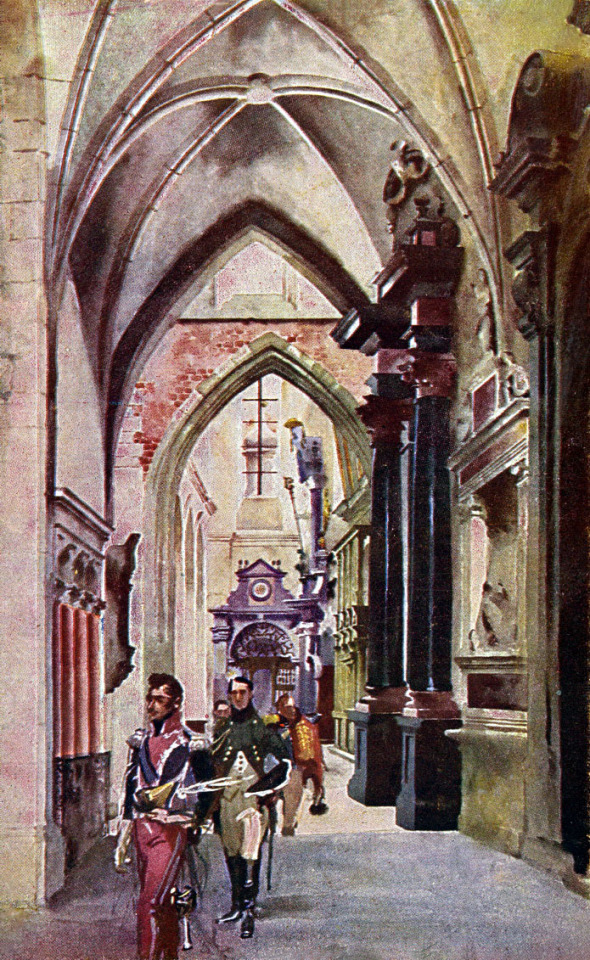
Józef Poniatowski in the Cathedral after Kraków was taken from the Austrians, an image by Stanisław Tondos and Wojciech Kossak
Most probably prince Józef visited the Wawel cathedral during his sojourn in Kraków that time. (In a small voice: little did he know that in 8 years he’ll be buried there...)
And after exactly a month since the Polish troops entered Kraków, there was a ball arranged in the Cloth-hall, the image depicting it I have already posted here.
#Poniatowski#Jozef Poniatowski#józef poniatowski#1809#Galicia#Lublin#Sandomierz#Zamość#Kraków#Austro-Polish War#Konstanty Gorski#Michał Stachowicz#Stanisław Bagieński#Wojciech Kossak#Feliks Piwarski#Kajetan Koźmian#Dezydery Chłapowski#ambroży grabowski
32 notes
·
View notes
Text
Józef Poniatowski’s children and descendants
Because a couple of months ago there’s been a discussion about Napoleon marshal’s children I decided I out to share with you the info about Józef Poniatowski’s issues and descendance.

Though never married, prince Józef nevertheless had two illegitimate sons.
The oldest one was Józef Szczęsny Mauricy Chmielnicki, born on the 17th of September, 1791.
The mother of the boy was most probably Poniatowski’s mistress of that time, the actress named Małgorzata Magdalena Wiktoria “Zelia” Sitańska (though there are as well versions it might have been another woman, for example, Zelia’s step-mother, also an actress - more on the topic I wrote here)
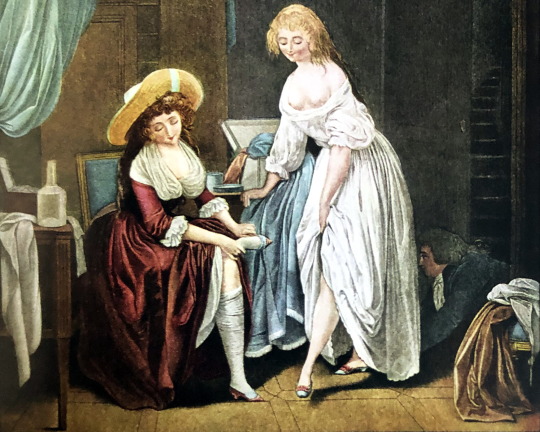
Zelia and here step-mother, a colored engraving
As for the fate of the boy - in his youth (before 1807) he started a military career in the Army of... Austria. Most probably it was prince Józef himself who arranged it, because his career started in the Austrian army too. (Another question is why Poniatowski didn’t “transfer” his son into the Army of the Duchy of Warsaw after the latter had been created, but, I’m afraid, we’ll never know the answer.)
And when in 1809 Austria attacked the freshly created Duchy, Józef Chmielnicki took part in the war... on the side of the Austrians. (And his father kinda accepted this, because in his will written 3 years later, in 1812, Poniatowski mentioned not only his firstborn but as well the fact that the latter was an officer in the Austrian Army.)
Chmielnicki fought as well in the next coalition wars, in 1812-1815 (against Napoleon as well), in 1831 he fought in defense of the Roman ecclesiastical state against local insurgents; for this he received the papal Order of St. Gregory. He also had the Austrian Military Cross. In 1856 he retired with the rank of colonel. He died unmarried in Vienna in 1860.
Unfortunately, I wasn’t able to find any image of Józef Chmielnicki, but in his military service records there is a little bit on his appearance:
Tall, of good health, very lively temperament and honest and reliable character. Polite and tidy; sometimes a bit violent and not always consistent. Zealous and active, with a special penchant for service in rifle units. He was wounded twice. He is fluent in German and Polish in speech and writing, speaks French and a little Italian. A very good staff officer, suitable for a regiment commander.
More do we know about Prince’s Józef’s other son, who was born on the 18th of December, 1809 in Warsaw and was then was given the name Józef Karol Ponitycki.

Józef Peszka, Portrait of Józef Ponitycki, 1815
As for Józef the second mother - there are no doubts in it, it was prince Poniatowski’s another mistress, Zofia Czosnowska née Potocka (more about her - here).
Though Czosnowska was married, prince Józef acknowledged her child and mentioned him in his will.

A miniature showing Ponitycki at the age of ten
The boy’s mother, however, didn’t care for her child much. Having divorced her official husband she married again in 1815, then placed her son in the custody of his aunt, prince’s Józef sister countess Maria Teresa Tyszkiewicz.
In the 1821 countess Teresa became the boy's legal guardian (Czosnowska officially gave him up) and in 1828 adopted him, changing his surname from Ponitycki to Poniatowski and adding Maurycy (Maurice) as his third name, thus making the boy the namesake of her long-term love Charles Maurice de Talleyrand.
And a little bit before, in 1826, Józef the younger gained French citizenship, and at the age of 18 (1827) he volunteered to join the French army.
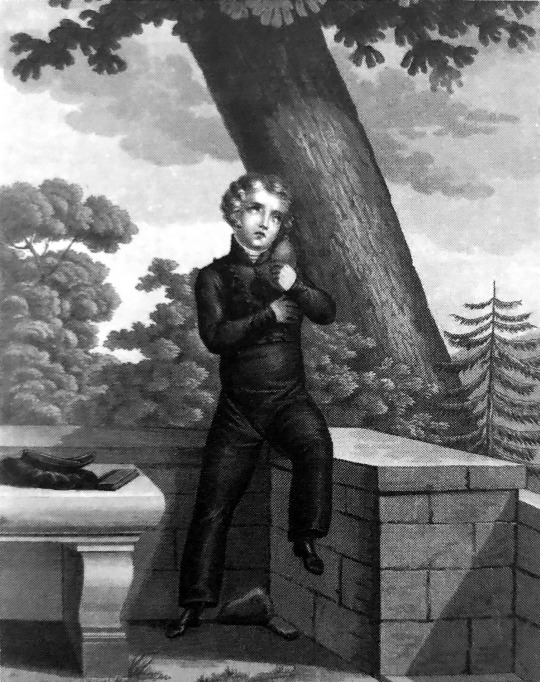
An anonymous painter, Prince Józef's son grieving after his father, 1820
The enlistment papers say that he was a healthy, blue-eyed, tall (1.79 m) blond, oval face, strong chin and aquiline nose. After graduating from school, he took part (as chasseur sergeant) in the Greek campaign in the Peloponnese (1829), later he was transferred to Algiers (1830), but he quickly returned to France.
During the July Revolution in Paris that year Poniatowski was among those soldiers who were putting it down, but when a year later the November Insurrection broke out in Poland he, together with his friend, Count of Montebello, a son of the Marshal Lannes, went to Poland to join the uprising. After the fall of the uprising, Józef returned through Galicia to France, where joined the rifle regiment as a captain and took part in the war in Algiers with Abd del-Kader in the years 1832-1836.

Józef Ponitycki-Poniatowski charges the camp of Emir Adb-el-Kader, a drawing by a French painter Eugène Chaperon
In 1839, driven by longing for his homeland, Poniatowski came to Kraków and made efforts to obtain permission to return to Warsaw. But the Russian Governor Paskevich refused him entrance and even tried (unsuccessfully) to confiscate) properties Józef inherited from his father and aunt.
Not being allowed to return to Poland, Poniatowski returned to France and to his regiment. He died on February 15, 1855 in Tlemcen, Algeria, and was buried there.
As for Józef Karol Poniatowski’s private life - in 1836 he married an Englishwoman, Maria Anna Semple. They have two children - a son, Józef Stanisław, born in 1837, and a daughter, Maria Teresa, a year younger.
Józef Stanisław joined the army at the age of 17 and went on the Crimean campaign. During the siege of Sevastopol, he was appointed lieutenant for his bravery. He then served in the cavalry regiment. He left the service due to ill health. In 1866 he married Victoria Charner, the daughter of a French admiral, the chief commander of a sea expedition to China. He died in Paris in 1910.
As for Józef Stanisław’s issue - there we have a kind of discrepancy. According the Polish sources like, for example, the Genealogy of the Descendants of the Great Sejm , he died childless but according his profile at geni.com he did have a son, named André whose descendants still live in the US. (The site doesn’t allow to see all the data but it is highly probably that the direct male line continues till our days.)
Maria Teresa, after the death of her father, was taken care of by the Duchess d'Eckmühl, the widow of the Marshal Davout. In 1859, Maria Teresa married Louis de Guirard, Comte de Montarnal, grandson of Marshal Ney. He was an official in the Ministry of Treasury. They had seven children: three sons and four daughters. But neither of those, according both the Genealogy of the Descendants of the Great Sejm and Geni.com had issue.
What’s more, according Geni.com Józef Karol Poniatowski after the death of his first wife married again. That time he took as a wife a woman named Elżbieta Fuchs, and they have a son named Wojciech Józef. That Józef, it looks like, was married, but no information about his issue is provided.
#Poniatowski#józef poniatowski#zelia sitańska#Józef Szczęsny Mauricy Chmielnicki#zofia czosnowska#Józef ponitycki#józef karol maurycy poniatowski#józef poniatowski's children#józef poniatowski's descendants#józef peszka#eugène chaperon
22 notes
·
View notes
Text
Prince Poniatowski entering Saxony in June 1813
After leaving Kraków in May 1813, the Polish Army was originally supposed to go to Bavaria. However, having received news of Napoleon's victory over the coalition in the battles of Lützen and Bautzen, Prince Joseph directed the army to Saxony. On June 16, he reached Zittau, the first city on the Saxon side of the border.
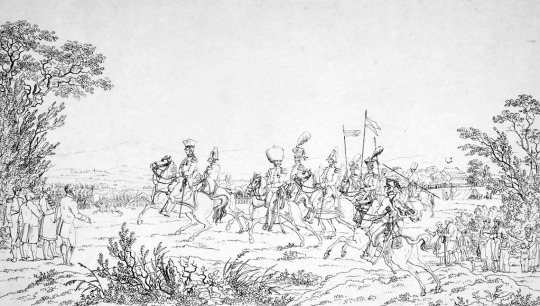
Carl Beyer, Prince Józef Poniatowski after Revue – Zittau 1813
The locals greeted the Polish Army very warmly. And one of the residents, Carl Beyer, immortalized those moment on an amateur sketch.

Bronisław Gembarzewski, Commander-in-Chief's Staff. Zittau 1813
What’s more, in Zittau there was already an order from the Emperor to prince Józef to come to Dresden. So Poniatowski, having waited for the rest of the corps to arrive, went then, on the 20th of June, to the headquarters of the Grand Army in the Saxon capital.
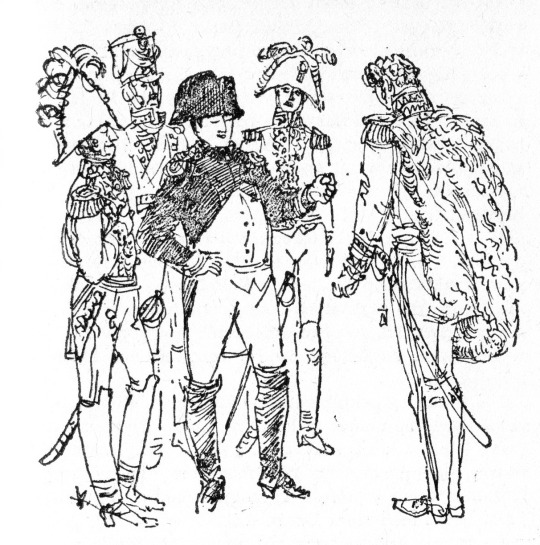
Zbigniew Łoskot, prince Poniatowski meeting emperor Napoleon in Dresden in June of 1813
#Poniatowski#józef poniatowski#napoleon#1813#Saxony#Zittau#Dresden#Carl Beyer#Bronisław Gembarzewski#zbigniew łoskot
11 notes
·
View notes
Text
The battle of Zieleńce (1792)
On occasion of the battle of Zieleńce, which took place during the Polish–Russian War of 1792 (War in Defence of the Constitution) let me show you some images related.

Aleksander Orłowski "Prince Józef Poniatowski in the battle of Zieleńce”
The battle took place on the 18th of June, 1792. By that time the war has been going on for a month already, and since its beginning the Polish-Lithuanian Commonwealth Army had been in retreat. On the eve of that day, on the 17th of June, Poniatowski, the commander of the of the Kingdom of Poland's Crown Army, finally received the long awaited reinforcements. And the next day the Poles defeated one of the Russian formations of general Irakly Morkov.
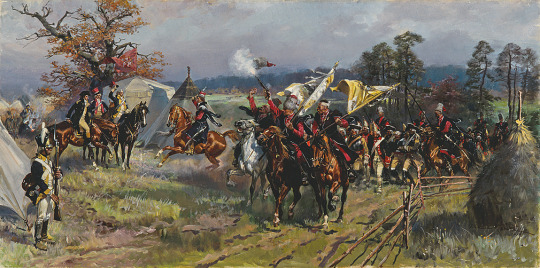
Wojciech Kossak "After the Battle of Zieleńce" (Józef Poniatowski together with Tadeusz Kościuszko are reviewing the parade of Polish troops)
Besides Poniatowski other Polish commanders like Tadeusz Kościuszko, Michał Lubomirski, Stanisław Mokronowski and Józef Wielhorski took part on the battle.
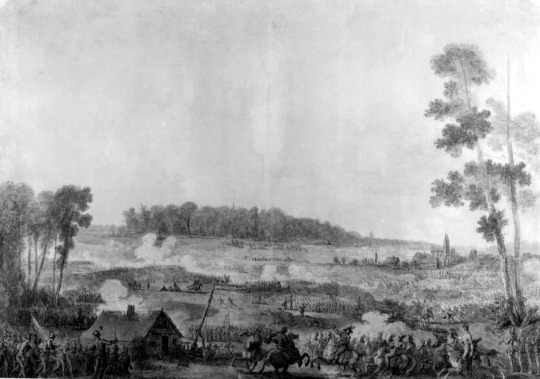
Jean Pierre Norblin, “The battle of Zieleńce”
That victory over Russian was the first Polish one since John III Sobieski, and to honor it the king Stanisław Augustus created the War Order called Virtuti Militari. Prince Józef was among the first people decorated with it.

Star to the Grand Cross of Virtuti Militari which belnged to Prince Józef Poniatowski
#józef poniatowski#poniatowski#1792#Polish-Russian war#the battle of Zieleńce#aleksander orłowski#wojciech kossak#jean pierre norblin#tadeusz kościuszko#virtuti militari
12 notes
·
View notes
Text
Józef Poniatowski’s favourite horse
Having seen this post of @joachimnapoleon about Murat’s favorite horses I decided to share with you a little bit on the topic of prince Józef’s equine preferences.
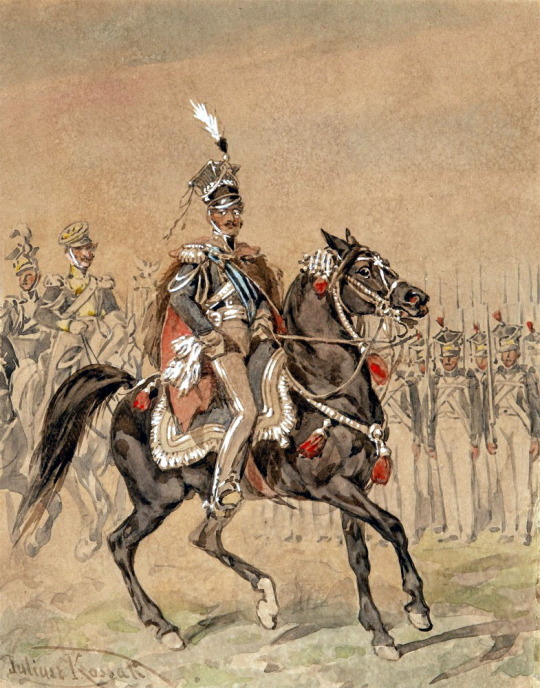
Juliusz Kossak Prince Józef Poniatowski on Szumka
As for horses coat color - Poniatowski’s favourite was bay. History even preserved for us the name of one of Prince Józef’s mares - Szumka. What’s more interesting it’s the origin of this name - “szumka” is a Ruthenian folk dance, which Poniatowski liked and would dance.
28 notes
·
View notes
Text
Napoleon dancing near Berthier
An anecdote about Napoleon from a collection of Polish soldiers memories:
"Do you know, madame," said the emperor to his partner at the moment of rest, "why do I always put Berthier opposite me in the dance? I do it by coquetry: he dances like a bear, and so I seem a little better than him."
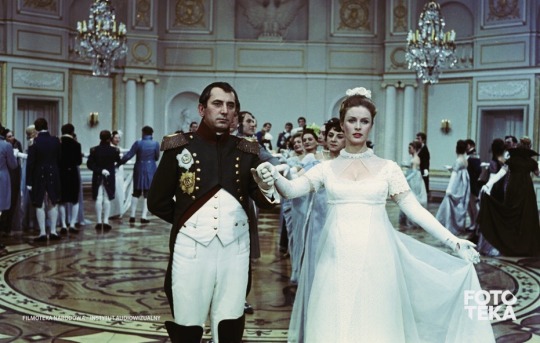
A screenshot from the movie “Marysia i Napoleon” from here
65 notes
·
View notes
Text
Józef Poniatowski’s last evening in Kraków
As I mentioned in the previous post the first units of the Polish Army began to leave Kraków on the day of Prince Józef's birthday, the 7 of May. Poniatowski himself was supposed to leave on the 9th, so the day before Krakow’s high society organized a party in his honor.

Lipki near Krakow, drawing by Antoni Kozakiewicz from 1877
According to Juliusz Fałkowski:
The Krakow Society, under the leadership of Pani Zamoyska, asked him on the eve of his departure to have a farewell party in "Pod Lipkami" near Zwierzyniec. The prince attended this invitation with his staff and some generals, and in the shade of those old spreading lindens, which at this season of the year formed a sort of canopy of flowers and fresh greenery above their heads, amidst the charming landscape at the foot of Mount St. Bronisława, with the wide ribbon of the Vistula stretching out in picturesque bends in front of him, the royal Wawel bathing his feet in it to the left, and picturesque Bielany with its monastery to the right, our hero spent the last pleasant and happy moments of his life.
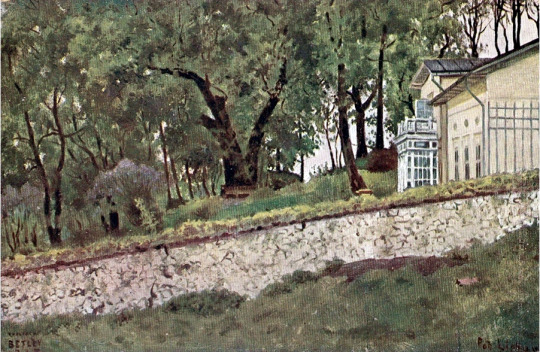
A postcard with a view of Lipki , before 1918
I haven't been able to find any pictures showing this place in around 1813, but the images made in the following years give some idea of how it might have looked like back there.


Photos of the manor house made in 1913


A view from Lipki to Kraków and „The linden of Pani Zamoyska" - the same one that supposedly witnessed prince Poniatowski's visit to the places, photos made in 1913
Over the last 100 years the estate has changed a lot; only a plaque from 1913 commemorating the prince's stay in this place survived to our time.


How this place looks like nowadays
24 notes
·
View notes
Text
Prince Józef Poniatowski’s place of birth
Good evening, dear Tumblr friends, and thank you all for the posts and re-posts about Pepi’s birthday! It was very pleasant to see such things in my feed 😊
As for me, on today’s occasion I would like to show prince Józef’s place of birth.
258 years ago he was born in Kinsky’s palace in Vienna. Yes, prince Józef parents lived that time there, because his father served (in the rank of general) in the Austrian army. (As for the mother - she was of a Czecz nobility, and Kinsky was her family name).

This is how the Kinsky palace looked like about 10 before prince’s Józef’s birth.
And this building still exists, and now it looks like this:
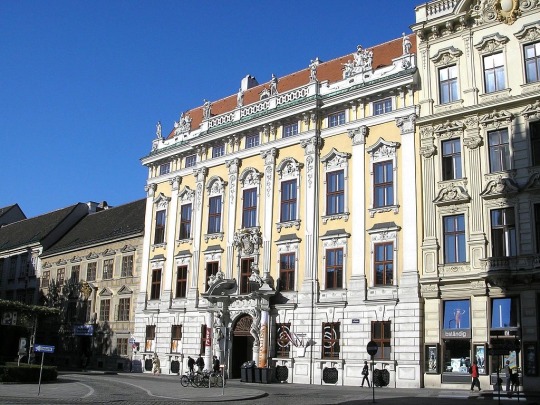
(I am sorry, the photo is not mine, last year I had planned to visit Vienna, but all was cancelled by the reasons we all know…)
And on the same day when he was born prince Jozéf was baptized, getting names Józef Antoni on honor of his maternal and paternal uncles (Antoni was the second name of the future Polish king Stanisław August).
The ceremony was held in the nearest church named Schottenkirche (The “Scottish” church) which can be seen on the right side of this picture, painted about 20 years before:
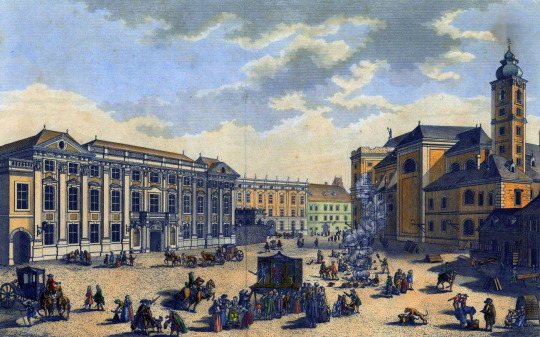
Btw, the yellow building in the back center is just the Kinsky palace. (And the place in the foreground is called the Schottenplatz).
The church also exists now, and looks like this:
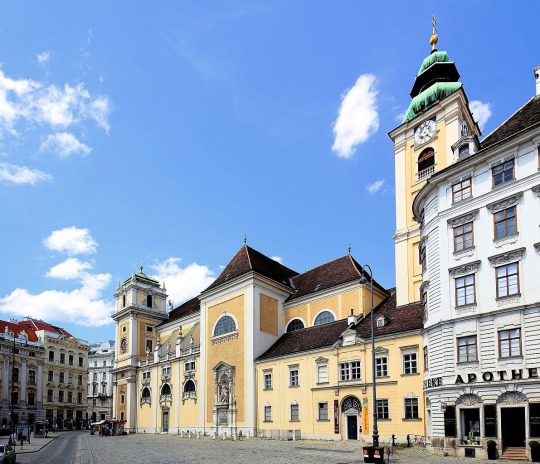
And one more modern view:
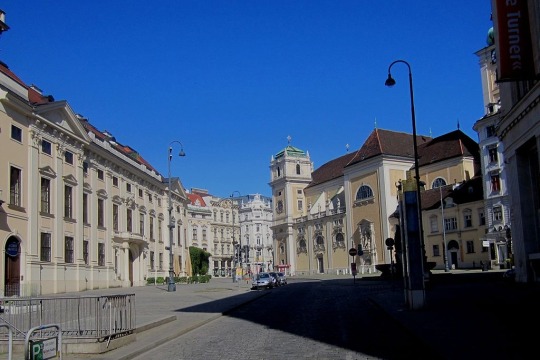
That’s all for now, thank for your attention!
And I hope one day I will be able to show you my own photos from this place.
PS For those who like my “Photoshops” - there is one old image I didn’t show you yet:
Keep reading
36 notes
·
View notes